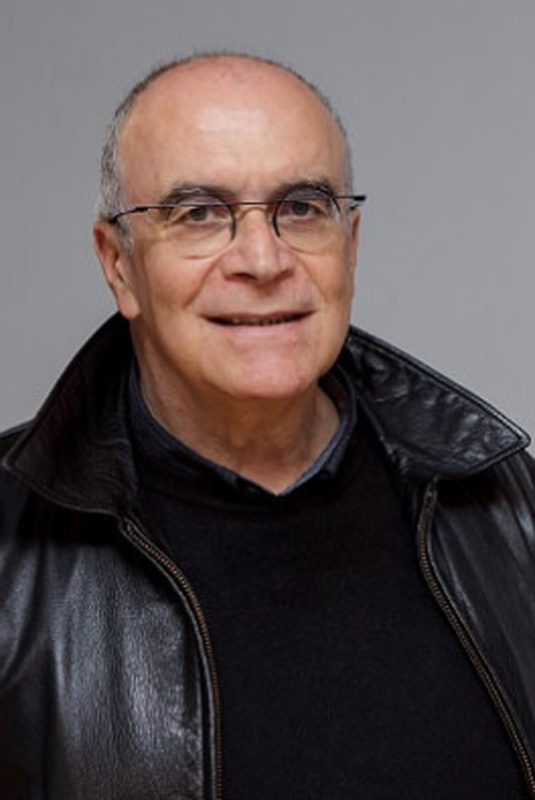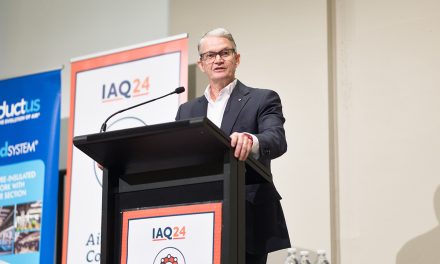A new building material developed at the University of New South Wales holds great promise for ameliorating one of the biggest consequences of climate change: urban heat. Ecolibrium’s Mark Vender breaks bread with its head designer, Professor Mat Santamouris.
By Mark Vender
Earlier this year, news spread through the HVAC&R world that a research team from the University of New South Wales had developed innovative materials that could moderate building temperatures.
Designed by Scientia Professor Mat Santamouris at the School of Built Environment, UNSW Arts, Design & Architecture, the materials change the amount of heat that surfaces emit and reflect, based on surrounding temperatures. This makes the materials attractive not just for reducing urban heat in summer, but also for reducing the heating loads of buildings in winter.

Professor Mat Santamouris
“Urban overheating is perhaps the most documented problem of climatic change. Recently, the National Academy of Sciences published a paper that the number of overheating hours between 1980 and today has tripled.”
Ecolibrium
What was the genesis of the project, and how did you get involved?
Professor Mat Santamouris: This is a journey that started almost 20 years ago when I used to work in Greece as a professor there, and then in Singapore for many years, and it continues now here in Australia.
Urban overheating is perhaps the most documented problem of climatic change. Recently, the National Academy of Sciences published a paper that the number of overheating hours between 1980 and today has tripled. So it is a serious problem, and we feel it. There are more than 120 cities in Asia and Australia that suffer from urban overheating.
One of the major solutions that has been developed during the past 20 years has to do with so-called reflecting materials. These reflect solar radiation, so they do not absorb heat, and keep their surface at low temperature.
How are the materials you have developed different?
They are a combination of the latest generations of materials [see breakout].
Photonic materials, which we are already using, have a disadvantage. Because they emit the radiation in the atmospheric window, during the winter, they may create a problem of overcooling – you may have a penalty.
But if this material is covered by another layer of smart material, it has modulated optical properties. This means that during the summer the material may present surface temperatures up to 20°C lower, but during winter may be up to 10°C higher. By using them we may decrease the peak summer temperatures of cities by 4–5°C and increase the peak temperatures of cities during winter by up to 2°C. It’s a win-win.
Another disadvantage of photonic materials is that because they have a reflectance of 97 per cent, they cannot be used on low-level surfaces like pavements. It creates glare and contrast – it’s used only on the roofs of buildings.
So instead of having a very reflective substrate, we use coloured materials of much lower reflectivity. Of course, we lose the high performance, and the cooling efficiency is lower. To compensate, we have combined fluorescent and photonic. So, although we lose some performance because of the lower reflectivity, the energy absorbed by the coloured material is re-emitted as fluorescent radiation and the total balance is close to zero.
And now there are some materials that emit more than they absorb. When you put them under the sun, they cool down instead of heating up. This is fantastic, this is a new generation of materials. We have included these into the combination of the other materials, so in this case we don’t need a very high reflectance because we have a very high fluorescence.
Material world
Professor Mat Santamouris provides a quick history of building materials.
First generation
Development started around 20 years ago with white, very reflective materials, though they had already been used traditionally in hot climates. These decreased peak temperatures of cities by up to 0.5°C.
Second generation
White cannot be used everywhere, so infra-reflective materials were developed that could be any colour. Because 50 per cent of solar radiation is in the infrared spectrum, these materials are also very reflective, lowering surface temperatures by 10–15°C.
Third generation
Thermochromic materials change colour as a function of ambient temperature, and can change from black in winter to white in summer without any intervention. This avoids the problem of “overcooling” in winter.
Fourth generation
Photonic materials present very high reflectivity of around 97 per cent. Importantly, they emit the infrared radiation into the atmospheric window – part of the spectrum where the atmosphere is open. In other words, the excess heat of the city is sent into space.
Fifth generation
Fluorescent materials use quantum dots, nanomaterials that have a very specific property – they do not absorb heat. When radiation falls on the surface, it is immediately re-emitted as fluorescent heat.

As part of an ARC Discovery Project, UNSW and the University of Sydney tested photonic materials in Alice Springs in 2021. The ambient temoerature was 44°C; the surface temperature of the materials was 25°C.
What form do these materials take?
It can be a paint, or a solid surface, or whatever you want. It’s not a problem to present it under any kind of structure. Of course, this affects the price.
On that subject, we hear about a lot of interesting developments in the area of building materials, but the great challenge seems to be getting them to market. How do we bridge that gap?
There’s always a gap between research and implementation, inevitably. But we have started implementing photonic materials in cities. These are commercially available.
In Australia, the federal government has asked us to perform a study on the potential of cool roofs. This is almost finalised, and we have found that by implementing cool roofs – and I’m not discussing fourth- and fifth-generation materials, I’m discussing second-generation materials, infrared reflective materials – we can decrease the peak temperature of our cities by up to 2.5°C. And we can decrease the energy consumption of buildings by up to 30–35 per cent. Also, we can have a tremendous impact on peak electricity demand.
We are in discussions with the government about including the requirement for cool roofs in the new building code. We already succeeded in convincing the NSW government, and they banned dark roofs in Western Sydney.

The new materials combine photonic and fluorescent qualities.
“Recently, the National Academy of Sciences published a paper that the number of overheating hours between 1980 and today has tripled. So it is a serious problem, and we feel it.”
How did that change come about?
We had discussions with (former NSW Minister for Planning) Rob Stokes. We performed a mitigation study for Western Sydney and for Parramatta and Blacktown, so we had a lot of documentation, and we presented it to the government. Minister Stokes was convinced, and he banned dark roofs and made the use of reflective roofs mandatory in Western Sydney. We’re in discussions with local government in Queensland to do something similar.
My experience is from Europe, where I was responsible for this development as president of the National Energy Research Authority. When we started it took three years to convince the politicians all around Europe to believe in us. Once we had the very first demonstrations and showed that it is possible to decrease the peak temperature and this was measured, people could understand it immediately. The second year we had 70 new applications. And now there are more than 150 industries in Europe producing cool materials.
In many countries, like Greece, Southern Italy, Spain, parts of France, it is mandatory to have reflective roofs. In California it is almost mandatory, and it’s the same now in Florida, Arizona and New Mexico.
It takes time for people to understand, to convince the decision-makers, and to fight against the inertia that exists in the public sector, because there is always inertia, not only in Australia but all around the world.
What do you think can help overcome that inertia?
In general, you introduce energy efficiency into the market through legislation. Of course, there’s knowledge and education, but legislation is very important.
You need to implement it through the national construction code, when it is mature and you know it offers added value for the country. This offers a lot of added value in terms of energy efficiency, in terms of energy conservation, and in financial terms.
The decrease of the ambient temperature in cities increases the energy efficiency of air conditioning. We found for all Australian cities that by having cool roofs and cool pavements, the average increase of the EER of air conditioning is up to 15–20 per cent, which is tremendous.
Secondly, the cooling need is much reduced, so you don’t need such big air conditioning units. And third, the peak electricity demand is much lower because these materials decrease the peak temperature, so during the peak period the cooling demand is much lower. These are major benefits.
Also, these materials are produced in Australia. They generate a lot of employment and wealth – it’s very positive. We have about 15 industries producing these materials now, and exporting them all around the world.
Tree change
Though extremely useful, natural and pleasing, urban green space is not a panacea for the heat island effect.
Professor Mat Santamouris notes that public policy often focuses on increasing green spaces to address urban overheating, but there are some important issues to consider with this approach.
“It’s really simple, for example, to plant five million trees in New South Wales,” says Professor Santamouris. “But five million trees in New South Wales, first, will increase the water consumption by up to 14 per cent.
“Second, it will increase humidity by up to 10–15 per cent.
“Third, some trees, and unfortunately some native trees in Australia, produce VOCs that generate ozone. We have seen that in places with a very high density of this kind of tree, there is a tremendous increase of ozone.
“And fourth, the worst thing, is the following: Trees produce cooling through evapotranspiration up to a certain ambient temperature. But above 36°C, trees don’t circulate sap, and you don’t have evapotranspiration. This is the reason that during heatwaves the temperature inside urban parks is higher than the temperature in the city. And because the colour of their leaves is dark, the surface temperature of the trees is higher than the ambient temperature, so they contribute to heating.
“Increasing green infrastructure is really very positive, but you have to take into account the drawbacks.”












